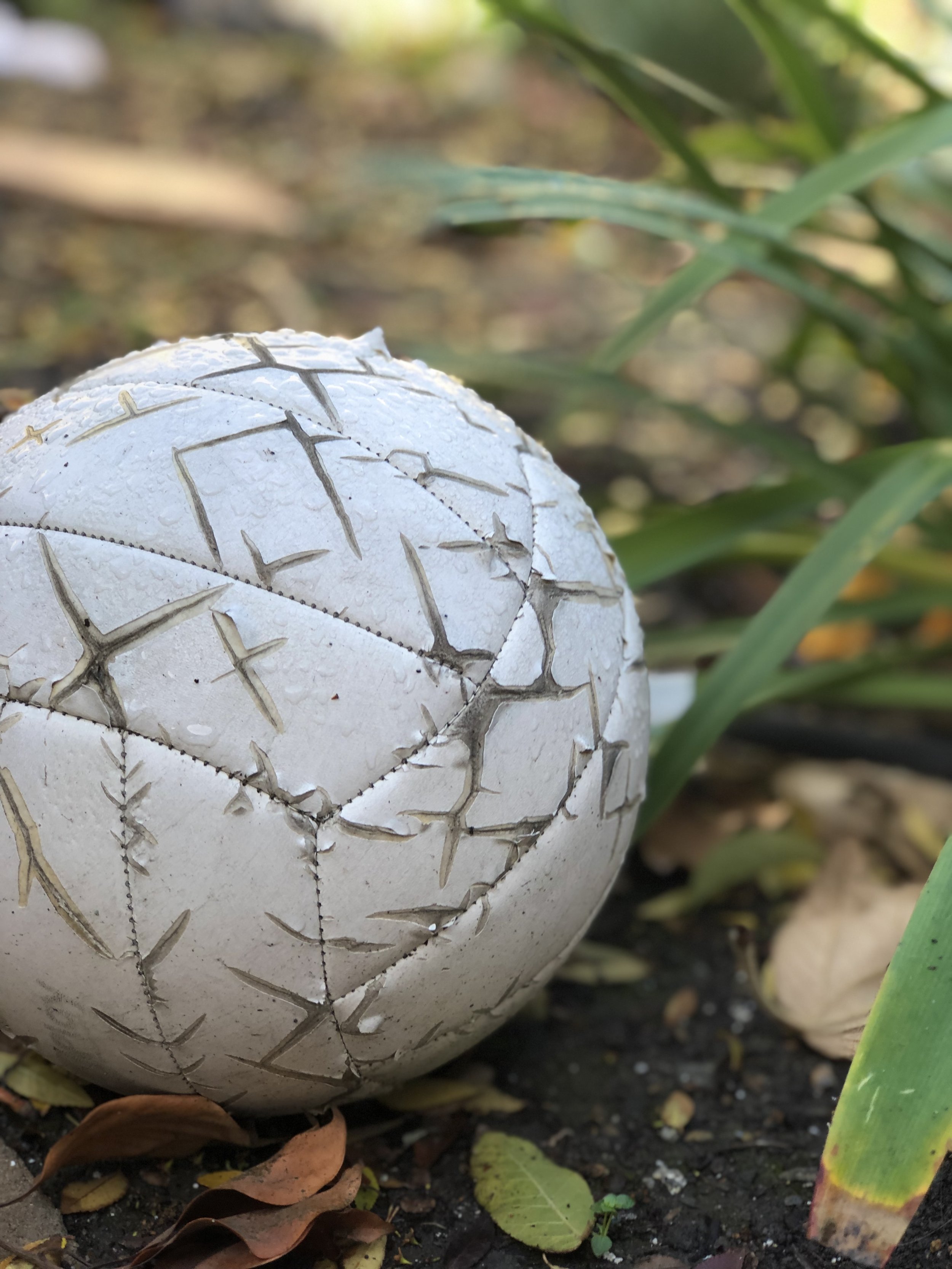"My Brief Soccer Career" by Dave Seter
My Brief Soccer Career
It must have been about the time the international soccer star simply known as Pele signed a contract with the New York Cosmos to leave Brazil and play his chosen sport in the United States. The Cosmos were part of the North American Soccer League, which, at the time of Pele’s signing, had been in existence for nearly a decade. But professional soccer had failed to attract much attention in the United States, being in competition with our own national sport, a more violent brand of football, played not in jersey and shorts but shoulder pads and helmets.
Although of strong build, Pele probably would not have taken to American football. But for the American youth, playing high-school football was a way to prove their manhood and, perhaps, to attract cheerleaders. Pele seemed too careful of his appearance to play a sport that could cause disfigurement. He was very photogenic and, from what I remember from the New York Daily News, he liked to flash his smile at photographers. Did I blame him? No, I would have done the same if born with the confidence Pele displayed, whether smiling or performing his famed bicycle kick on the field of play.
How is the bicycle kick performed? First of all, to perform the kick, the soccer ball can’t be on the ground. The kick can only be performed once someone has already kicked it off the ground. The ideal height for the ball when struck by a bicycle kick is at least two feet, but no more than three, off the ground. Keeping their eye on the ball, the striker leans backward, becomes airborne, and strikes the ball back over their head toward the goal. The rotation caused by the striker’s body wheeling through the air is why it’s called a bicycle kick. To actually score a goal off such a kick requires incredible aim, but the ball can be struck with such force it sometimes takes the goalkeeper by surprise. Given that few goals are scored in any given soccer match, whether it succeeds or not, the bicycle kick is a work of performance arc that never fails to thrill the crowd.
I would have smiled like Pele if I could because I was an awkward teenage boy in need of a little flair, attending Northern Valley Regional High School in New Jersey. The campus was located in Bergen County, stepson or stepdaughter to Manhattan-of-the-gleaming-skyline on the other side of the Hudson River. Not being of athletic build like Pele, nevertheless I had always been good at kickball on the grade-school playground and figured I could kick a ball across a soccer field as well as anyone else. As a high school freshman, I joined tryouts for the team. Players were issued clunky secondhand cleats, although true athletes brought their own fresh-bought off the sporting-goods-store shelf, sturdier models better suited to their ankles and feet. Our practice uniforms consisted of navy-and-gold shorts and tank-tops. Oh, those school colors. They still do something for me. Our mascot? Not so much: the Golden Knight.
What Pele’s arrival did was energize high-school boys to try the sport, to try that patented bicycle kick, and to cultivate their smiles for the camera should they score a winning goal someday. Our high school coach was also an immigrant, a man who taught Spanish in the school and was, in fact, from Spain, a nation where soccer was the national sport. He seemed to expect that we, though new recruits to the sport, already knew rudimentary facts about the game: number of players per side; typical formations; rules about slide tackles; and how to strike a ball with one’s head in addition to feet. But I had never been taught these things. One of the reasons I was an awkward teen is that I had never been taught how to throw a baseball, how to tune a car engine — how to be a man — much less how to play soccer the way it was meant to be played.
I can’t even remember at tryouts what position was I told to play by coach. Defense? Midfield? I was fairly quick on my feet — coach watched us run wind sprints — so I think I played midfield, which required running both forward on offense and backward on defense. The first practice I chased the ball around the field like a reckless, angry wasp. Wherever the ball was kicked, I’d follow, instead of holding my position. Soccer is played in formation, though it might not seem like it to the spectator watching the sport on television. Players may seem to be running everywhere, ping-ponging the ball back-and-forth, but they’re not. Suffice it to say, a midfielder playing on the right wing shouldn’t suddenly sprint to the middle of the field or race toward the goal just because he sees a teammate doing the same. The teammate might actually be a forward, also known to aficionados of the game as a striker, and it’s his job — and his job alone — to sprint toward the goal and strike the ball past the keeper into the net.
It seemed to me I was running in circles. To be truthful, I was running in circles. When I did kick the ball, it was just as a teammate was trying to do the same. More than once, our toes or ankles met, painfully. I felt the pain was my fault and apologized a lot on the field — sorry — sorry. After a while I was subbed out — this was just a scrimmage — shirts against skins — maybe being a skin, with my skinny body, made me want to run and hide in the crowd. I didn’t want to stand alone on the right wing, naked to the wind, the sun burning down, turning away the gazes of nonexistent freshman girls.
The next day, when I showed up to practice, the coach took me aside and asked for my cleats and uniform. I had been cut after the first day of practice. I was the only one cut after the first day of practice. I could sprint. I could kick a soccer ball fifty yards. But I could not play soccer. Nobody had taught me. Nobody was going to teach me. The coach was so insistent in his stern look of disapprobation that I didn’t question his judgment. Soccer was not the game for me. I would wait for spring, for track-and-field when I could sprint, running the 100- and 200-yard dashes in meets against other schools. Our junior-high team had won the 4 × 200 relay with me running the second leg. I had received the baton in third place but had jetted to the front and proudly handed the baton off in the first position, much to my teammates’ surprise. Yes, I could fly. Looking back, I realize I wasn’t even that great a runner, maybe 90th percentile. But my track-and-field career was non-objectionable, if not marked by stardom. I think I scored three points for the team, in total, my senior year.
But I could still kick a soccer ball.
I proved just that during gym class the same year I was kept off the team. I had won a free kick, which is what happens when another player fouls you by tugging on your jersey, or tripping you, or committing a similar infraction. One of the members of the soccer team was standing adjacent to me, and I asked if he wanted to take the kick, but he said no and motioned for me to take it. I was about thirty yards from the goal — an audacious distance from which to score — ask Pele, who didn’t score many goals from thirty yards out but who did perfect the bicycle kick. Not the least bit nervous, I ran up to the ball and whaled on it, striking just the right spot at just the right angle. I was good at physics and understood force, and I was good at trigonometry and understood angles.
I didn’t score a goal on that kick. But the arc of the ball as it soared through the air was a thing of beauty, godlike, the work of an Olympian — or a Golden Knight. The ball dipped as it reached the goal, and the surprised goalkeeper — who was the keeper on the high-school team — had to leap into the air to parry the ball just over the crossbar. I had come within a fingertip of scoring a goal. The member of the soccer team who had let me take the kick said wow, slapped me on the shoulders, and said I should try out for the team. I was no Pele, but I still looked at him and smiled.
Dave Seter
Dave Seter is a civil engineer, poet, and nature writer. He is the author of Don’t Sing to Me of Electric Fences (Cherry Grove Collections) and Night Duty (Main Street Rag). He is also a translator of contemporary Lithuanian poetry. His writing is informed by his environmental career protecting drinking water and healing the scars of mineral extraction across the continental United States. His writing has appeared in various journals, including Appalachia, Confluence, The Hopper, Tupelo Quarterly and others.
On Instagram: @daveseter_ecopoet
More at: https://daveseter.com/
Headshot: Dave Seter
Photo credit: Tiffany Le


